NOTE: Since this article was written a number of years ago, Alloy USA has undergone some changes. In my humble opinion, it is not the company it use to be and the quality isn’t there anymore. Ron Stobaugh, who was the driving force behind Alloy USA, has parted ways with them and started a new company, Ten Factory. Ten has hooked up with Motive Gear. Were I in the market for new shafts, I would be contacting them for my needs. I’ve left this write-up on my site simply because it documents what is needed to do this work.
Quite a few years ago (I am probably dating myself on this one), there was a commercial for a fast food franchise that had a little ol’ lady in it, you know, the one that looks like the text book Grandma. The commercial was all about there not being enough meat in the hamburgers. During the commercial, she would say in her best critical grandma voice “Where’s the beef?”
Where’s the beef? If you are talking about axle shafts, then the answer is the new Alloy USA 30 spline outer shafts.

If you are looking for some “real beef” for your Dana axle, then a pair of 4340 chromoly dual heat-treated inner shafts and the new 30 spline outer shafts is just what the doctor ordered. Just to be sure, I got out my marking pen and counted off 3 groups of ten splines on the new outer shafts. OK, I’m convinced now that they really are 30 spline shafts.
Since the stock unit bearings that come on our TJs are setup for 27 spline shafts, your new shafts require new unit bearings. Of course, Alloy USA has these too.
My buddy, BradW, stopped by over the weekend for the installation in his Rubicon. I told him he had to let me take some photos and help with the wrenching. In return for this, I also told him that lunch was on him. (yep, I strike a pretty hard bargain!) Brad showed up at 9:00 AM and we got to work.

Angel supervised BradW as he put his Rubicon on the jack stands. Remember folks, BE CAREFUL when doing projects like this. Cinder blocks and such are NOT suitable for holding the front end of your Jeep while you work on it…..I don’t care what Uncle Bubba has told you! Use jack stands with an adequate load rating to support your vehicle. Set the parking brake and leave it in gear (or Park).
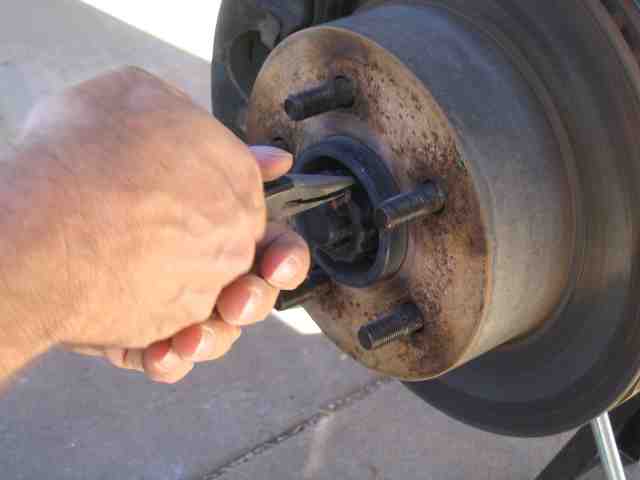
With the tires removed, grab a pair of needle nose pliers and remove the cotter pin from the end of the axle shaft. Remove the nut retainer and the little springy thing under it. Set them aside as you’ll use them during assembly.
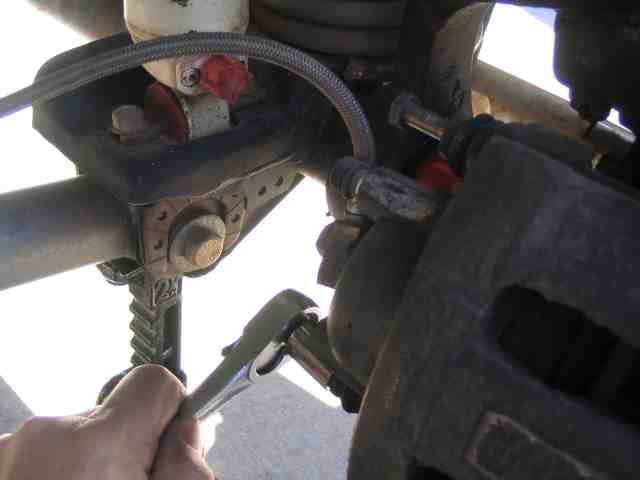
Remove the caliper retaining bolts from the back side of the brake calipers. Keep these too, obviously, as you will be putting your brake calipers back on before you call this project complete. When both bolts have been removed, you can pull the caliper off of the rotor. Sometimes it may be a bit tight and so a small pry bar or large screwdriver can be used to help slide the caliper off of the rotor.
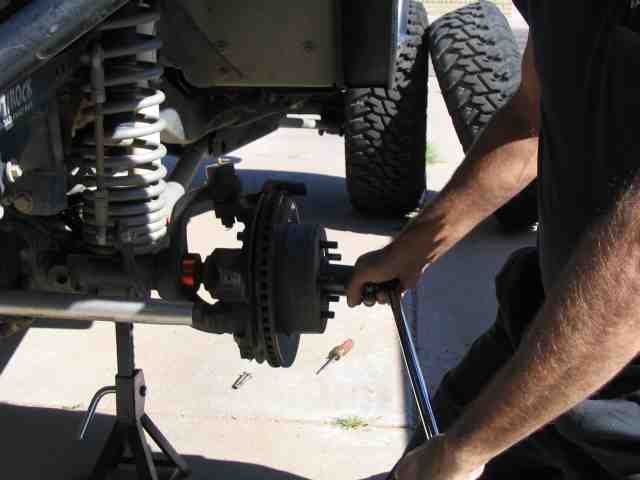
BradW uses a 2′ long breaker bar on the 36mm axle nut. Would you believe me if I told you my air compressor was on the fritz? (not really…..I don’t have one…..keeping your arms good and strong by wrenching all those bolts by hand is a good thing!) Note that there is a large flat washer under the 36 mm nut. And yes, keep both of these as they will be reused.
To keep the axle shafts from turning when removing the axle nut, you can do one of two things. Number one, put the vehicle in 4WD and lock your lockers, which is what BradW did to keep the axle shaft from turning. Number two, you can slip something through the u-joint (hey, still got that big screw driver?) to bind it up which also works (the alternative I normally use).

After pulling the rotor off of the unit bearing’s wheel studs, use a 12 point socket or wrench to remove the three 13mm bolts from the back of the knuckle. These secure the unit bearing in the knuckle. And yes, you’ll need the three bolts when putting everything back together.
More 30 Spline Shafts
30 Spline Alloy USA Outer Axle Shafts
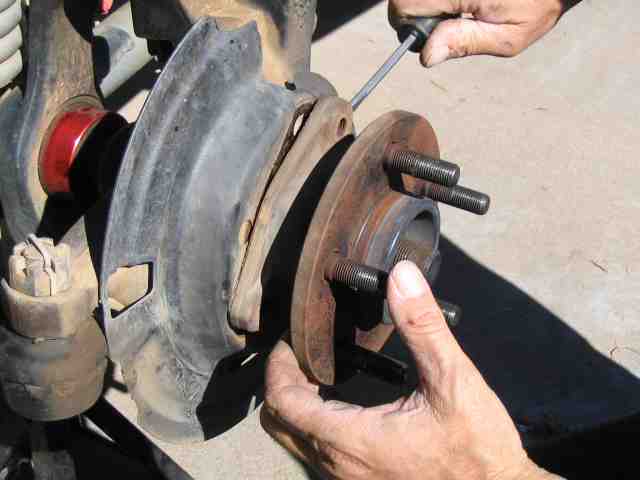
Depending on where you live, the outer shell of the unit bearing can get a bit rusty which makes removing it from the knuckle a good challenge. BradW had just a bit of trouble with this one but nothing major. He was able to slip a screwdriver blade in behind the unit bearing to help pry it out of the knuckle. If they are rusted in there, start with a good soaking of penetrating fluid, such as PB-Blaster (WD-40 is not penetrating fluid).
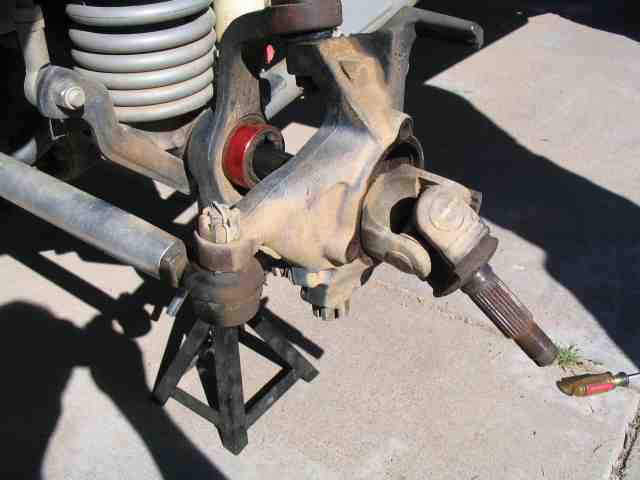
With the unit bearing removed from the knuckle, the axle shaft can be slid straight out of the axle tube. In case you were wondering, the red “thing” around the inner axle shaft is an aftermarket seal to help keep dirt, mud, water, etc. from entering the open end of the axle tube. They use a grease fitting (and your grease gun) to fill the sealing area with grease to help keep the foreign material out.
The old shafts were removed from the axle tube and the new shafts were slipped into the axle tube. Slowly rotate the axle shaft while pushing on it….this allows the splines in the differential to get lined up and the axle shaft will slip into the differential.
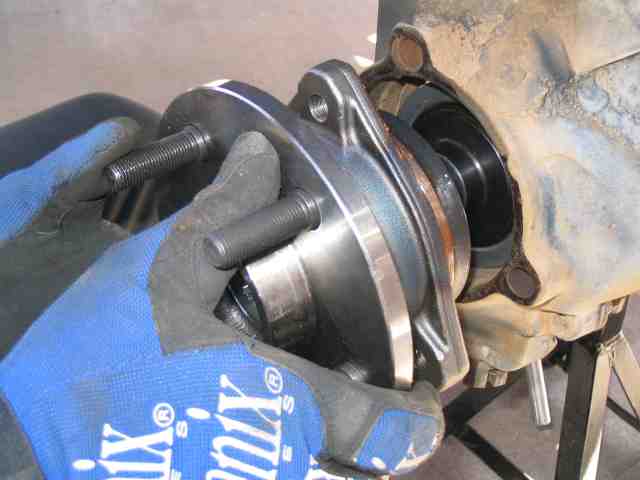
With some anti-seize compound spread around the mating surface of the unit bearing (where it contacts the knuckle), BradW slipped the new 30 spline bearing assembly into the knuckle. I must call your attention to the fact that BradW has completely forgotten to put the dust shield on. Because of this, he will find that after getting the bearing fully into the knuckle with a couple of bolts screwed in, it all has to come back apart so he can put the dust shield back where it belongs.
From here, it is easy. Put the 3 bolts into the back of the knuckle to secure the unit bearing in place. The bolts are torqued to 75 ft. lbs. The 36 mm axle nut is torqued to 175 ft. lbs. Don’t forget that flat washer that goes under the axle nut.
Place the rotor over the unit bearing wheel studs and then slide the caliper onto the rotor, lining it up on the caliper mounting bracket. If you have problems sliding the caliper onto the rotor, take a c-clamp and gently depress the inner brake pad a small amount. This will push a small amount of brake fluid back into the system, opening the gap between the brake pads.
With the rotor in place, replace the caliper mounting bolts. Use a little silicone grease on the bolts to help aid the caliper in positioning itself without getting bound up. The bolts are torqued to ONLY 11 ft. lbs. Folks this is NOT very much at all. Don’t over-torque the bolts and strip them.
Don’t forget the cotter pin and the axle nut retainer.
That is about it. Do this again on the other side, put your tires back on, and torque the lug nuts to 100 ft. lbs. Remove the jack stands and if you had it in 4WD, now is a good time to put it back into 2HI (so you don’t forget).
So, the next time you hear that “Where’s the beef?” comment, you can point to your front axle and say “Right there….30 spline shafts….but who is counting?”
Good trails to you and remember to TREADLightly!
